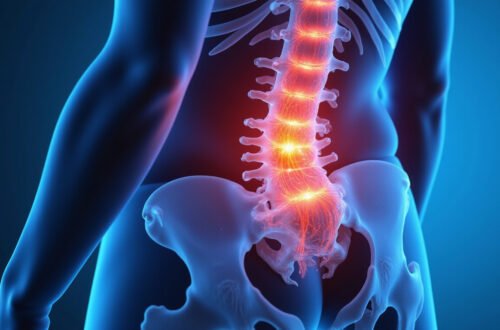Sciatic nerve injury can significantly affect a person’s quality of life, causing pain, weakness, and numbness that may interfere with daily activities. Understanding the symptoms, causes, and effective treatment options for sciatic nerve injury is essential for timely intervention and recovery. In this article, we will explore the nature of sciatic nerve injury, identify the most common signs and causes, and discuss comprehensive approaches to treatment that can help restore function and alleviate discomfort.
What Is Sciatic Nerve Injury?
The sciatic nerve is the longest and thickest nerve in the human body, extending from the lower back down through the buttocks and legs. A sciatic nerve injury involves damage or irritation to this nerve, which can lead to pain, weakness, or sensory changes along its path. This type of nerve injury may result from trauma, compression, or underlying medical conditions. Because the sciatic nerve controls muscles and sensations in the lower extremities, any impairment can create significant challenges.
Common Symptoms of Sciatic Nerve Injury
Recognizing the symptoms of a sciatic nerve injury is the first step toward diagnosis and treatment. Symptoms may vary depending on the severity and location of the injury but typically include:
- Radiating pain: Sharp, burning, or shooting pain that starts in the lower back or buttock and travels down the leg, often reaching the foot.
- Numbness and tingling: A "pins and needles" sensation or loss of feeling in areas served by the sciatic nerve.
- Muscle weakness: Difficulty moving the leg or foot, sometimes causing a foot drop (inability to lift the foot).
- Reduced reflexes: Diminished knee or ankle reflexes on the affected side.
- Difficulty sitting or standing: Pain or discomfort that worsens with prolonged sitting or standing.
It’s important to note that less severe cases may present primarily with pain, while more significant injuries might also involve motor and sensory losses.
Causes of Sciatic Nerve Injury
Several factors can contribute to the development of sciatic nerve injury. Understanding the underlying causes can guide treatment and prevention strategies:
- Herniated or bulging discs: One of the most common causes is a slipped or ruptured disc in the lumbar spine that compresses the sciatic nerve roots.
- Spinal stenosis: Narrowing of the spinal canal can pinch nerves and cause sciatic symptoms.
- Trauma or injury: Direct trauma to the lower back, pelvis, or thigh can damage or compress the sciatic nerve.
- Piriformis syndrome: The piriformis muscle in the buttocks can irritate or compress the sciatic nerve if it becomes tight or spasms.
- Surgical complications: Certain pelvic or hip surgeries can inadvertently injure the nerve.
- Prolonged pressure: Sitting for extended periods on hard surfaces or carrying heavy loads can cause nerve compression.
- Medical conditions: Diabetes and infections can contribute to nerve damage leading to sciatica-like symptoms.
Identifying the root cause is crucial for creating a targeted treatment plan.
Diagnosing Sciatic Nerve Injury
A healthcare professional typically begins the diagnosis with a thorough clinical evaluation, including:
- Review of medical history and symptoms
- Physical examination to assess reflexes, muscle strength, and sensation
- Imaging studies such as MRI or CT scans to identify disc problems or nerve compression
- Electromyography (EMG) and nerve conduction studies to evaluate the electrical function of muscles and nerves
Prompt diagnosis allows for early intervention, which is vital to prevent permanent nerve damage.
Effective Treatment Options for Sciatic Nerve Injury
Treatment of sciatic nerve injury depends on the cause, severity, and individual patient factors. Most cases improve with conservative management, although some may require more advanced interventions. Common treatment options include:
1. Conservative (Non-Surgical) Treatments
- Physical therapy: Tailored exercises and stretches help relieve nerve compression, strengthen supporting muscles, and improve flexibility.
- Medications: Pain relievers such as NSAIDs (ibuprofen, naproxen), muscle relaxants, or neuropathic pain medications (gabapentin, pregabalin) help manage symptoms.
- Activity modification: Avoiding prolonged sitting, heavy lifting, and certain movements can prevent worsening symptoms.
- Heat and cold therapy: Ice packs reduce inflammation, while heat therapy helps muscle relaxation.
- Epidural steroid injections: Administered in some cases to reduce inflammation around the nerve roots.
2. Surgical Treatments
Surgery may be necessary when conservative treatments fail, or there is progressive neurological deficit. Common surgical options include:
- Microdiscectomy: Removal of the herniated portion of a disc to relieve nerve pressure.
- Laminectomy: Removing part of the vertebra to widen the spinal canal and reduce nerve compression.
- Nerve repair or grafting: In cases of traumatic nerve injury, surgical repair may restore function.
The decision for surgery is made after careful evaluation and consideration of potential risks and benefits.
3. Complementary Therapies
Some patients find added relief through complementary approaches such as:
- Acupuncture: May reduce pain and improve nerve function.
- Chiropractic care: Spinal adjustments could alleviate nerve compression.
- Massage therapy: Helps decrease muscle tension and promote circulation.
Preventive measures focus on maintaining spine health and avoiding trauma. Recommendations include:
- Practicing good posture, especially when sitting for long periods
- Using ergonomic furniture and supportive seating
- Exercising regularly to strengthen core muscles
- Avoiding heavy lifting or using proper techniques to lift objects
- Managing underlying health conditions, such as diabetes

Frequently Asked Questions About Sciatic Nerve Injury
Q1: How long does it take to recover from a sciatic nerve injury?
Recovery time varies depending on the severity and cause. Mild cases may improve in a few weeks with conservative treatment, while more severe injuries may take months or require surgery for full recovery.
Q2: Can sciatic nerve injury cause permanent damage?
If left untreated or in severe trauma cases, sciatic nerve injury can lead to permanent muscle weakness or sensory loss. Early diagnosis and treatment are crucial to prevent long-term complications.
Q3: Is sciatica the same as sciatic nerve injury?
Not exactly. Sciatica describes the symptoms of radiating leg pain caused by irritation of the sciatic nerve, whereas sciatic nerve injury refers specifically to structural damage to the nerve itself.
Conclusion: Taking Action Against Sciatic Nerve Injury
If you suspect you have a sciatic nerve injury, promptly consulting a healthcare provider is essential to prevent worsening symptoms and potential long-term disabilities. Through an accurate diagnosis and a comprehensive treatment plan—including physical therapy, medications, and in some cases surgery—you can effectively manage pain and restore function. Don’t let sciatic nerve injury control your life. Start your journey to recovery today by seeking professional guidance and committing to proven treatment strategies that work.
For more expert insights on managing nerve-related conditions, visit the Mayo Clinic’s detailed resources on sciatica and nerve injuries. (source)






